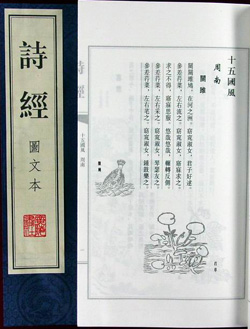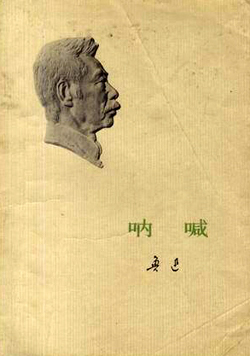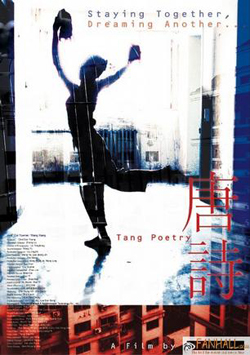|
|
Chinese
literature: what to read and how to read it
By Brigitte Duzan - January 6, 2017
Questions about how to choose what to read when willing to read
Chinese literature, and especially fiction, are recurring ones.
But the problem is not only what to read, it is also
how to read.
Reading entails from the start a double problem: a problem of
selection and a problem of appreciation. For a foreign reader
trying to read Chinese literature, this double problem is a
daunting one, made all the more difficult by the cultural gap,
which starts with the language.
Originally conceived as a blog and developing into a website,
http://www.chinese-shortstories.com/
was created with a view to helping bridge that gap, based on a
few key ideas, including the conviction that online publication
is the most efficient, most flexible way of gradually building
up what is meant to be, in a fluctuating future, a kind of
literary encyclopedia, that is a guide to reading.
But it is a selective one, reflecting personal readings,
research, and aesthetic tastes. And starting from two main
assumptions.
Assumption one:
being non-Chinese, you don’t read a Chinese book the way you
read any other book pertaining to your own culture. You can, but
you often lose the gist of the story, be it fiction or, still
more, non-fiction.
|
Chinese literature has indeed a universal appeal, based
on shared longings, sufferings, fears, simple joys,
bitter frustrations, and a similar human fate. Anybody
can sympathize with a grieving mother, a dying soldier,
an elated lover, an aging artist, and generally the
common man around the corner, which might be your own
neighbour.
Even the most ancient Chinese poems, those mostly
anonymous of the Book of Songs (or Classic of
Poetry) dating to the 11th to 8th
century BC, are for a good part short pieces recording
the voice of the common people like common people
everywhere, with joys and sorrows, and little hope for
Heaven’s support or the King’s benevolent help.
The difference comes with the expression of those
feelings, which makes it unique, unique as individual
expression, but |
|
 |
also as part of a culture which gives it a certain resonance. In
that sense, the best Chinese literature has this same special
quality as the ancient Chinese shanshui
paintings, landscape paintings of "water and mountain" which the
literati perceived as part of an inner experience, something
that has to resonate with your own feelings, deep at the heart
of your own self.
In that sense, too, this brings us to the second assumption.
Assumption two:
anybody wanting to read a Chinese book does so because he or she
has at least a vague interest in China, the country and its
people.
The nature of this interest will direct the eventual choice to
be made among a vast array of available titles. It is therefore
best for any reader to be able to have a good idea of the
content and style of the book, but also of the author’s
personality and of the context of his writings. And knowing more
about all of this will then help the reading too.
The first choice to be made is about the period:
classical literature or modern and contemporary literature. Both
are a reflection of their time, but written in a totally
different language, a difference that may however be partially
erased in a translation, especially given the tendency to
“smooth” a text as you smooth wrinkles.
In its first approach,
chineseshortstories’
main interest focuses on modern and contemporary
literature, because it gives the most vivid image of
present-day China, but also because it is a rich period of
experiments, starting with the language, from the beginning of
the 20th century which saw the birth of the
vernacular
baihua,
at the end of the 1910 : a new form of expression closer to the
spoken language and closer to a broader readership than the
literati of yesteryear, the field of experiment being the
short story.
|
Under the auspices of Lu Xun, the short story then
became the ideal mode of expressing sharp social
criticism, and, as time went by and the failure of the
1911 Revolution became clearer by the day, increasing
disillusion, grief, and qualms about the future.
Not that it was something unheard of; the short story is
in fact the origin of fiction in China. The first
stories, as fiction, found in ancient texts dating back
even before Christ, were labelled xiaoshuo,
literally “small talk”, gossips and chatter that the
literati frowned upon and despised, as they despised the
popular novels which began to appear in the 13th
century, based on folk tales of lore.
So it was a revolution of sorts when Lu Xun paved the
way for that same short story to become the foremost
mode of |
|
 |
expression of the Chinese intellectuals of the 20th
century, but revolution in literature was but one of the
revolutions of the time.
The
short story came back to the fore after the Cultural Revolution,
at the end of the 1970, when literature was revived and renewed.
The short story – and the novella growing in its wake for
narrative purposes – was then the crux of another round of
fruitful experiments following one literary movement after
another all along the 1980’s, until its apex, at the end of the
decade, in an avant-garde movement that was crushed not so much
by the fateful events of 1989, but by a new trend which led to
the development of commercial literature in the following
decade.
Writers were urged, by editors, to write novels, and they did,
giving rise to an unending flow of family sagas more or
less modeled on Ba Jin’s
Family,
back in the 1930’s, or Lao She’s Four Generations Under One
Roof, published in 1949. As these sagas chronicle the fate
of families in all kinds of areas of the country, and usually
span half a century from the end of the Qing Dynasty, they
constitute a vivid illustration of changing ways of life in
various parts of the land, as part of a historical process far
from the main events of the period as learned in history books.
But the 1990’ also saw the rise of novels praised by
Western critics, and readers, for their social and political
criticism, sometimes expressed in jocular fashion, which makes
them all the more attractive. These novels gave rise to a great
number of translations, and their authors became world-famous.
They include the 2012 Nobel Prize, Mo Yan, but others deserve at
least equal attention, although they might not have so many
available translations.
The trend continued well into the 2010’s, but times are changing
again. By the mid-2010’s, the novel is running out, and the
trend is again toward the short story and the novella, written
by young writers not so much of the riotous post’80 generation,
but by the much more mature generation of those born in the
1970’s, who are eventually achieving recognition. Each one has
his own style, but the majority of them build up a personal
universe based on recollections of the past, and inner feelings
about the present often hidden under a slight veneer of cold
humour.
They publish in a vast array of literary magazines all over the
country; the most difficult is to track them down, each
discovery, often haphazard, through hearsay or tip from a
critic, is the reward for the quest. And this quest is all the
more difficult that the best of the short story and novella
writers are now, in the last year or two, specializing in short
shorts, xiao xiaoshuo.
The xiao xiaoshuo has become the most refined, demanding
style, a cross of poetry, short story and essay. It is a new way
of writing, but with its own references in the past, especially
in one of the best Chinese writers of short stories ever, Pu
Songling, at the very end of the Ming period, a man of letters
who wrote in superb classical Chinese a collection of short
stories still considered a model today: the Tales of the
Liaozhai (from the name of his studio).
This is a perfect example of the way styles and genres evolved,
in China: even what seems revolutionary reflects an ancient
tradition, one way or another. This is a reason why, even if
your main interest lies in contemporary literature,
classical literature gives a useful framework, not only
for the sheer pleasure of its refined poetry and fiction, but
also because it offers a wealth of references and quotations.
This is the beginning of the story: how it all started.
Ancient legends, Tang Poems, Ming and Qing novels inform
present-day literature in a number of ways. Those are verses and
stories that Chinese children learn at school, and remember all
their lives afterwards; they become part of their inner world.
|
The film director Zhang Lü, for instance, titled his
first full - length feature “Tang Poetry” Tang Shi,
a subtle exercise on the solace found in poetry
remembered from the past in the dreariest moments in the
life of a young boy.
When asked about his title and subject, Zhang Lü
instantly replied, as if expecting the question: because
Tang poems are parts of our life, even in the most
difficult moment, there is always a poem, learnt by
heart, that emerges from the past, something of the
nature of dreams, that borders on the subconscious.
Some stories are old legends, creation myths, or just
anecdotes in serious books, some dating all the way back
to the Warring States period, some three or four
centuries before Christ, books like the Han Feizi
where they appear almost incongruous, but they have such
deep meanings that |
|
 |
they morphed into everyday four-character expressions that are
to be found everywhere in today’s writings.
Classical pre-Ming and Ming novels are especially interesting as
sources of stories that are part, from the earliest age, of the
subconscious of the Chinese people: Water Margins (or Outlaws of
the Marsh), Journey to the West or Dream of the Red Chamber, to
quote only three. These are not only fascinating stories,
objects of the most serious research, they are also part of a
sort of common popular subconscious that pervades writing and
life.
Take the first one, for instance, a masterpiece of vernacular
Chinese written at some time in the 14th century, we
are not even sure by whom. This is the story of a group of
outlaws who escaped arrest and punishment, for crimes allegedly
committed for rightful purposes, by taking refuge in a swampy
region called the Liangshan marsh; they are described as
creating there a kind of unruly society, with its own codes of
honour, fighting against a foul government.
The story is
based on supposedly historical events recorded during the Song
dynasty, and evolved
from folk tales told by storytellers from the Southern Song on.
They are known as the Liangshan heroes, and some of the stories
are so famous that they are quoted for their symbolic value in
literature and films, even today…
The novel is part of a rich set of collective images dating
back, again, to the Warring States period: images of noble
swords men fighting for justice and the redress of grievances,
known as xia, at the core of the so-called wuxia
literature. A term that has such a deep and variegated meaning
that it is hardly translatable, as is the word for the Liangshan
marsh: the jianghu, literally rivers and lakes, with its
rich connotations of rightful rebellion and life at the margins.
A word that often appears in today’s literature in expressions
as simple as: this is very jianghu… which immediately
calls to mind a whole set of images and ideas as subtle,
pervasive and difficult to explain as the delicate scent of a
flower.
Chinese literature is a world apart that can be read for its
stories, but gains much more flavour when approached as a gate
to a culture, and part of that culture.
Suggested readings for a start
(available in English translation)
·
Ancient Classics
- The Book of Songs, The Ancient Chinese Classic of Poetry,
translated from the Chinese by Arthur Waley, and edited with
additional translations by Joseph R. Allen and foreword by
Stephen Owen, Grove Press 1996.
- How to Read a Chinese Poem: A Bilingual Anthology, by Edward
Chang, Book Surge Publishing, July 31st, 2007, 448p.
- Outlaws of the March, translated by Sidney Shapiro, Foreign
Languages (Library of Chinese Classics, bilingual edition),
January 1999, 5 vol.
- Three Kingdoms: a Historical Novel, att. to Luo Guanzhong,
unabridged edition translated by Moss Roberts, University of
California Press, June 2004, 2 vol.
- Journey to the West, att. to Wu Cheng’en, revised edition
(initially published 1983), fully translated and edited by
Anthony C. Yu, University of Chicago Press, 2012, 3 vol.
- Cao Xueqin, Story of the Stone, or Dream of the Red Chamber,
translated by David Hawkes, Penguin Classics, 1974, 3 vol.
- Pu Songling, Strange Tales from a Chinese Studio (published
only in 1766), 104 stories translated by John Mindford, Penguin
Classics 2006, 608 p.
·
Modern Classics
- Lu Xun, The Real Story of Ah-Q and Other Tales of China: The
Complete Fiction of Lu Xun (1918-1935), translated by Julia
Lovell, Penguin Classics, 2009, 416 p. Including Diary of a
Madman, Kong Yiji and other stories of Call to Arms Nahan,
plus Old stories retold.
- Ba Jin, Family (1931), novel translated by Olga Lang, with
long preface written by the translator in 1972, at the time of
her translation, Doubleday & Co 1972 (reprinted 1979), 329 p.
- Mao Dun,
The Shop of the Lin Family & Spring
Silkworms (Bilingual Series in Modern Chinese Literature)
(1932), translated by Sidney Shapiro, the Chinese University of
Hong Kong 2001 (reprinted 2003), 200 p.
- Shen Congwen, Border Town (1934), translated by Jeffrey C.
Kinkley,
- Lao She, Rickshaw Boy (1936), translated by Howard Goldblatt,
Harper Perennial 2010, 320 p.
- Zhang Ailing/Eileen Chang, Love in a Fallen City, (1943),
translated by Karen S. Kingsbury, New York Review Books Classics
2006, 321 p.
·
Contemporary Classics
Some Novels
- Wang Meng, The Bolshevik Salute (1979), a “modernist Chinese
novel” translated by Wendy Larson, University of Washington
Press 1989, 174 p.
- Mo Yan, Red Sorghum (1986), translated by Howard Goldblatt,
Penguin Books 1993, 359 p.
- Jia Pingwa, Ruined City (1993), translated by Howard Goldblatt,
University of Oklahoma Press 2016, 536 p.
- Yu Hua, To Live (1993), translated by Michael Berry, Anchor
2003, 256 p.
- Wang Anyi, The Song of Everlasting Sorrow, translated by
Michael Berry and Susan Chan Egan, Columbia University Press
2010, 456 p.
- BiFeiyu, The Moon Opera (2000), translated by Howard Goldblatt,
Houghton Mifflin Harcourt 2009, 126 p
- Yan Lianke, Dream of Ding Village (2005), translated by Cindy
Carter, Grove Press 2011, 352 p.
Short stories and novellas
- Wang Anyi, Love on a Barren Mountain (1987), novella
translated by Eva Hung, Renditions Paperbacks 1991, 143 p. (1st
part of a “love trilogy”)
- Han Shaogong, Homecoming? and other stories [including PaPaPa
(1985) and WomanWomanWoman (1986)], four short stories
translated by Martha Cheung, Renditions Paperbacks 1992.
- Ge Fei, Flock of Brown Birds (1989), translated by Poppy
Toland, with a preface by Ge Fei, Penguin Specials 2016, 96 p.
- Ah Cheng, Three Novellas: King of Trees, King of Chess, King
of Children (1984, 1985), translated by Bonnie S. MacDougall,
New Directions 1990/2010, 208 p.
- Liu Xinwu, Black Walls and other stories, ed. by Don J. Cohn,
Renditions Paperbacks 1990, 202p
- The Time Is Not Yet Ripe, Contemporary China’s Best Writers
and Their Stories, ed. by Ying Bian, Foreign Language Press,
Beijing 1991, 382 p. (Ten short stories of the 1980’s with
introductions by Gladys Yang, Li Jun and others)
- Su Tong, Madwoman on the Bridge, 14 short stories translated
by Josh Sternberg, Black Swan 2008, 304 p.
Afterword
Short stories are underrepresented in available translations in
English. There are more translations available in French for the
period 1980’s-1990’s, thanks to the awareness, then, of several
publishers and translators,but novels have since taken over,
with the exception of some novellas requalified as short novels.
Publishers still live with the assumption that short stories
don’t sell.
Book publications must therefore be supplemented by literary
magazines, such as Renditions (Hong Kong), Chinese
Literature and Culture (New York/Guangzhou), Chinese Arts and
Letters (CAL, Nanjing), which complement translations with
useful articles about the writers and their works. Chutzpah/Tiannan,
launched by Ou Ning, was an invaluable source of discoveries of
young emerging writers while it lasted; published issues,
including translations, remain precious.
Chinese short stories, and novellas, have long been the basis of
Chinese fiction, and have recently gained new ground among young
writers. They are one of the best introductions to Chinese
literature, and to Chinese society, for a great many readers, as
well as a way to deepen their knowledge of the Chinese language
and culture for those who study it. This is where such
initiatives as Pathlight, Read Paper Republic or
chineseshortstories
find their worth.
Then, when all is said, and read, another way to appreciate, and
sometimes discover, Chinese fiction is to look into film
adaptations, as Chinese cinema, from its very inception, has had
close ties with literature. That was one of the reasons for the
launching of the twin website of chineseshortstories:
http://www.chinesemovies.com.fr/
But that would be another story…
|
|

